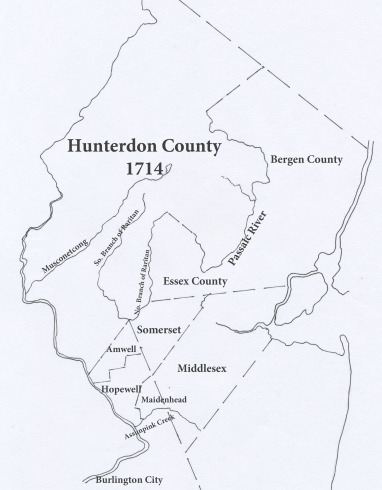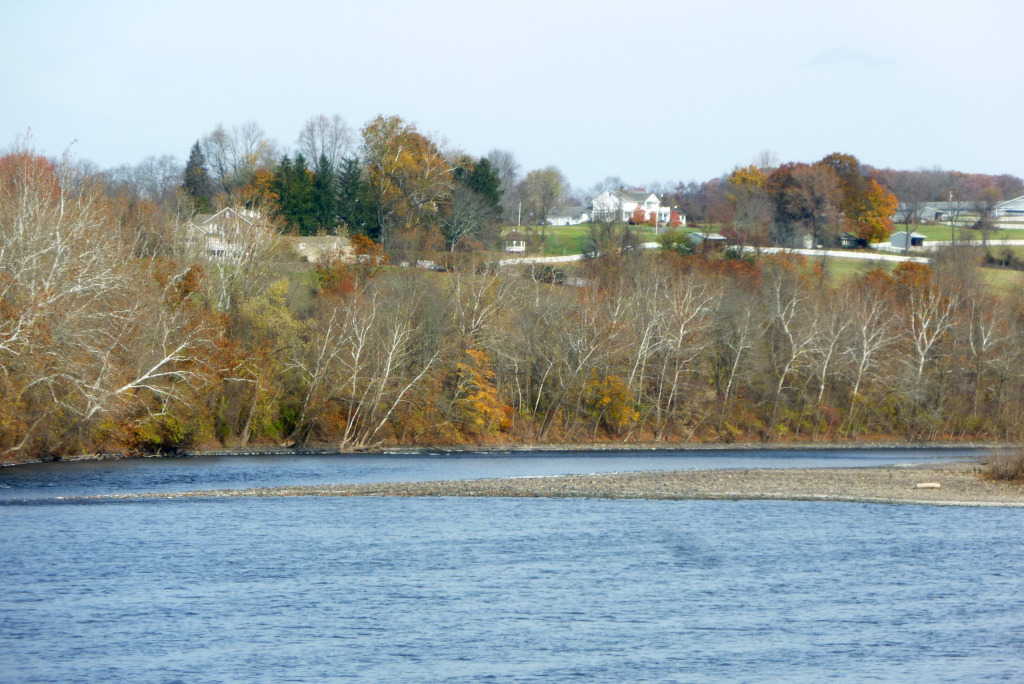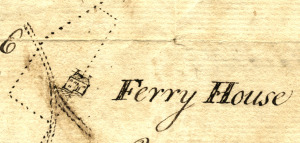For those of us who look for genealogical information in deeds, there is a very special word we hope to find: “Whereas.” This wonderful word introduces a clause that should appear in every deed, but often does not—the recital clause, which states who the seller of the property bought it from. Most of the time, that’s all it does—name the preceding property owner. But every once in a while, mostly in the late 18th and early 19th centuries, you will get a recital that goes all the way back to the beginning, to the original proprietary owner.
Reading
READING. There is probably no family more important to the early history of Hunterdon County than this one, starting with John Reading Sr. and wife Elizabeth who first settled here about 1704-08. Their son, John Reading, Jr., served as acting Governor in 1757. John Sr. and Jr. were active surveyors throughout northwestern New Jersey.
Return to Raven Rock
In 2011, I began a series of articles on the history of Bull’s Island, Raven Rock, and Saxtonville. (For the original post, please visit “Raven Rock and the Saxtonville Tavern,” where you will learn something of how the name Raven Rock began to be used.) Recently three documents turned up to shed more light on this subject–a deed of 1722, and two survey maps, one of them made in 1819 showing the original proprietary tracts. It is time to return to Raven Rock for another look.
The Creation of Hunterdon County, part three
This is the third and final part of a speech delivered on Nov. 16, 2014 for the Hunterdon County Tercentennial. You can find the first two installments here and here.
Petitioning for a New County

With so many surveys being made in the new Indian purchases, it was clear that people would be settling in this area very rapidly. And it was also clear that this new area was going to be hard to manage from far-away Burlington City. The residents of the northern townships in Burlington County were becoming frustrated by the need to travel 20 to 35 miles by horseback to the county seat to record their deeds, probate wills and attend court.1
John Reading and the Creation of Hunterdon Co., part two
This is part two of a speech delivered on Nov. 16, 2014 for the Hunterdon County Tercentennial. You can find the first installment here.
 Moving to Hunterdon
Moving to Hunterdon
I ended the last post with the statement that in 1704, John Reading had a tract of 1440 acres surveyed in the far northwestern corner of the Adlord Bowde purchase. It was an excellent location—superior agricultural soil and access to the river. At this point, the river runs east-west, so Reading’s house could face south as well as face the river, and he had an excellent view of traffic going both ways. He named it Mount Amwell, after his family’s ancestral home in England.
John Reading & the Creation of Hunterdon County (part 1)
On November 16, I gave a speech about John Reading and the Creation of Hunterdon County. There was quite a lot of information in that speech, covering the years 1664 to 1718. In fact, it was probably a bit too much.
For example, the beginning of the speech covered the conquest of New Netherland by the English in 1664, the Third Anglo-Dutch War of 1672-74, the Quintipartite Deed of 1676, and John Reading’s settlement in Gloucester County in 1684; also Edward Byllinge and the early settlement of West New Jersey. Rather than rehash material that I have already written about, you can see a list of pertinent articles at the end of this one. They cover the settlement of West New Jersey, its political history, its infamous governor Daniel Coxe, and the early career of John Reading.
For the history of Hunterdon County, it is best to start with 1694. What follows is the first part of a somewhat amended version of the speech.
A House Divided
Howell’s Tavern House and Ferry House

click to enlarge
The dotted line in this picture is a survey line, drawn by Reading Howell in 1774, and as you can see, one of the lines goes right through the middle of the house, which is labeled “Ferry House.” Strangely enough, this house has long been known as the tavern house at Howell’s Ferry (Stockton) which I wrote about in “Jacob’s Path, an 1813 Shortcut.” So why was the tavern house called the Ferry House in 1774? And why did the surveyor run a line right through the middle? Therein lies a story.
The Amwell Road of 1721
There is something fascinating about old roads, especially when their routes differ from the ones we know today. One of the very oldest roads in Hunterdon County was “layed out” in December 1721 and recorded in January 1721/22.
Here is the full text, as transcribed in Snell’s History of Hunterdon County (p. 347), which I will follow with my attempt to decipher what route was being described.1
Old Records Throw Light on the Ways of Past Ages
Law Once Compelled Every Town
to Have a Drinking Place
How “Amwell” Originated
by Egbert T. Bush, Stockton, NJ
published in the Hunterdon County Democrat, May 7, 1931
Sundry notes from old histories and other sources though jotted down in a haphazard way may serve to awaken thought or to throw light upon the ways of the past.
Richard Bull, Surveyor
The second in the series Hunterdon’s First Settlers
Technically, I should not include Richard Bull in the series “First Settlers of Hunterdon County,” since he never actually lived in Hunterdon, but he certainly qualifies as one of the first landowners. And he surveyed many of the first proprietary tracts here and even further north in Warren and Sussex Counties.
Richard Bull was a land owner in Hunterdon County, well before the county was created. Surprisingly, by the 20th century, even an accomplished student of Hunterdon history like Egbert T. Bush did not know exactly who he was. Bush wrote:1
“. . . “Bool’s Island” {was} the name of a famous long and narrow island opposite {Raven Rock}, which is said to have taken name from one Bool, who owned the island and much land ashore.”
Daniel Rittenhouse of Locktown
One of the most notable people in the neighborhood of Locktown in Hunterdon County was Daniel Rittenhouse. His life makes an interesting story, which we know something of thanks to the collection known as The Rittenhouse Papers, on file at the Hunterdon County Historical Society.